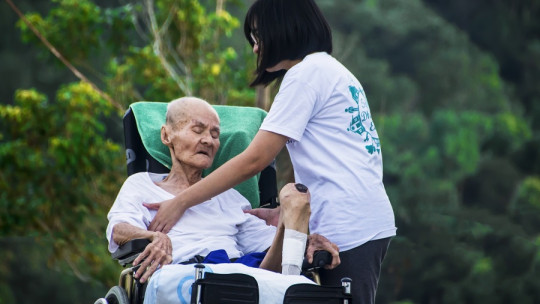Cognitive training in people with dementia It aims to tackle the symptoms that affect the quality of life of these patients and has been shown to be useful in slowing or delaying the deterioration of the affected cognitive functions.
Let’s see what this form of cognitive training is and how it can help people with dementia.
What is cognitive training?
The concept of intervention or cognitive training encompasses multiple methods and tools whose objective is work with the patient’s cognition to improve cognitive performance (or stop its deterioration) and behavior, with the ultimate goal of improving their quality of life.
Most of these cognitive training programs intervene in all areas of the individual: functional, cognitive, psychoaffective and social. It has been proven that a comprehensive intervention is more effective than working on separate aspects.
On a cognitive level, it is common for a program of this type for people with dementia to include a wide variety of activities to stimulate thinking and memory through games, music, crafts, etc.
Cognitive impairment in people with dementia
Dementias, and taking the case of Alzheimer’s disease (as it is the most common form of dementia), usually present an insidious onset and a progressive course, characterized by a loss of cognitive abilities and behavioral changes that progressively interfere with the patient’s autonomy.
This impairment of function is initially seen in advanced and instrumental activities of daily living, such as washing clothes, using a telephone, or managing medication. Later, basic activities are also compromised, such as personal hygiene, dressing or toilet training.
In the initial phases, memory is usually the most altered cognitive function , although it is not the only one nor does it deteriorate uniformly. It is also common for the person to be less and less able to plan activities, start and follow conversations, remember names and places, etc.
As dementia progresses, more severe disturbances appear such as errors in the recognition of objects (agnosia), reduction of speech and inability to understand more or less complex phrases and sentences (aphasia), and inability to carry out voluntary movements or gestures (apraxia).
The combination of this variety of symptoms usually gives rise to aphaso-apraxo-agnosic syndrome which characterizes Alzheimer’s dementia and relegates the patient to a state of permanent dependence, with assistance from a caregiver 24 hours a day.
Objectives of cognitive training in people with dementia
The objective of cognitive training in people with dementia is improve the adaptive functioning of patients in the family and social context
The most used techniques and strategies can be grouped into three levels that we will see below.
1. Restoration
Altered cognitive functions are stimulated and improved acting directly on them. In the case of dementia in advanced stages, the use of this technique is questionable, as the deterioration is already irreversible.
2. Compensation
It is assumed that altered cognitive function cannot be restored and An attempt is made to promote the use of alternative mechanisms or preserved skills in the patient.
3. Replacement
Is about teach the patient different strategies and tools that help you minimize the problems derived from altered cognitive functions. For example, educating in the use of external aid.
Main interventions of this type
Most cognitive training programs are based on the idea that keep the person active and stimulated, both physically and intellectually can slow or reduce functional and cognitive decline.
These are the main cognitive training programs used in people with dementia:
1. Reality orientation therapy
This intervention is a therapeutic method focused on improving the quality of life in people with dementia who suffer from confusion, through presentation of information related to orientation (time, space and person).
This information makes it easier for the patient to orient themselves and better understand their environment, giving them a greater sense of control and improved self-esteem.
The main objectives of this therapy are: to provide basic systematized and repetitive information so that patients can orient themselves better; achieve improvement at both a functional and social and family level; and stimulate communication and interaction of the patient with other people, as a complement to the modification of maladaptive behaviors.
2. Reminiscence therapy
Reminiscence therapy is a cognitive training technique with which it is about maintaining the personal past and perpetuating the patient’s identity Tools for stimulation, communication and socialization of the person are used.
People who suffer from dementia usually retain memories that are older, fixed and repeated or that have special emotional or personal meaning. The stimulation of memories and their expression can be very difficult for those with language disorders, but You can use songs or other types of sensory stimulation (such as smells or sounds) to achieve the desired effect.
The ultimate goal of reminiscence therapy is promote the expression of past experiences in the patient , in order to enhance your personal identity. To do this, group sessions are usually organized with people of similar age and similar affinities, and practical resources are used such as the person’s autobiographical books in which they talk about their childhood, work, their children or grandchildren, etc.
3. Tárrega comprehensive psychostimulation program
This psychostimulation or cognitive training program part of a globalizing and ecological vision of people with dementia and is based mainly on neuroplasticity, on the practical application of cognitive neuropsychology and behavior modification techniques.
Patients who complete this program come 5 days a week, 8 hours a day, and participate in the following workshops: cognitive psychostimulation in which orientation, attention, concentration, memory, language, calculation, praxis and gnosias are worked on; reminiscence workshop; kinesitherapy workshop (treatment through the use of movements); psychoexpression and music therapy; occupational workshop and maintenance of daily living activities workshop.
The implementation of this type of cognitive training programs requires few resources and has considerable beneficial effects It is not just about entertaining patients, but about establishing a routine and discipline and encouraging cognitive effort with different objectives: paying attention, making the mind work, etc.
New technologies with therapeutic potential
In recent years, a multitude of technologies and software applied to prevention and cognitive rehabilitation in people with cognitive impairment
Multimedia computer-based neuropsychological rehabilitation systems, video games and cognitive training games, online cognitive stimulation platforms and even devices based on EEG and brain-computer interface technologies designed to generate neuroplastic changes have been created.
Other technological tools such as virtual reality systems or tele-assistance, allow people with dementia to perform cognitive training exercises from home with the advantage that this means for them, by not having to travel and being able to carry out tasks in a safe environment.









